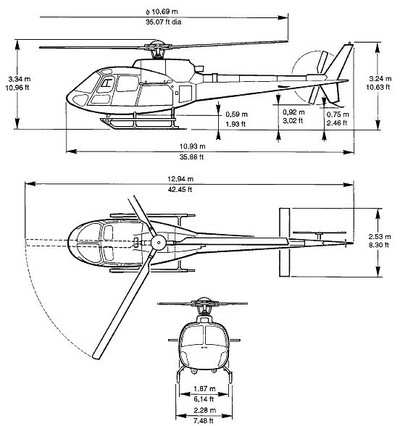Pilot Secured Helo, Reached For Lunch, Helo Takes Off...
OK... ouch. There are those who will tell you that they've done this kind of thing without a hiont of a problem... but securing a running helo, and relinquishing the ability to quickly retake control simply sounds like an accident waiting to happen... and this time, in particular, it was.

NTSB Identification: WPR13TA051
14 CFR Public Use
Accident occurred Friday, November 23, 2012 in Newfield, AZ
Aircraft: EUROCOPTER AS350, registration: N3984A
Injuries: 1 Uninjured.
This is preliminary information, subject to change, and may contain errors. Any errors in this report will be corrected when the final report has been completed. NTSB investigators may not have traveled in support of this investigation and used data provided by various sources to prepare this public aircraft accident report.
On November 23, 2012, about 1410 mountain standard time, an American Eurocopter Corporation AS350 B3 helicopter, N3984A, was substantially damaged following a loss of control while maneuvering near Newfield, Arizona. The helicopter was registered to the Customs and Border Protection (CBP), of Washington, D.C. The certified commercial pilot, the sole occupant, was not injured. Visual meteorological conditions prevailed for the routine air patrol mission, which was conducted as a Public Use flight, and a CBP flight plan was filed. The flight departed on the mission from the Davis Monthan Air Force Base (DMA), about 1210.
In a postaccident statement provided to the National Transportation Safety Board investigator-in-charge, the pilot reported that after he landed for a lunch break with the helicopter’s engine running at 100 percent flat pitch, he secured collective in the full bottom position and fractioned the cyclic. The pilot stated that as he was in the process of retrieving his lunch, the helicopter suddenly became light on its forward skids and began to slightly pitch up. The pilot further stated that at this time he corrected the slight pitch with forward cyclic to ensure skid contact with the ground.

The pilot revealed that within seconds the aircraft began to exhibit vertical dynamic oscillations that continued to worsen, at which time he applied collective to lift off in an attempt to regain aircraft stability. However, as the helicopter lifted off, an uncommanded downward change in pitch resulted in a nose-low attitude. The pilot stated that he then applied aft cyclic to compensate, but when in about a 5 foot hover the helicopter immediately began an uncontrollable left yaw. Due to the lack of tail rotor authority, the helicopter continued to pivot left for about 180 degrees before the pilot was able to land the aircraft. After securing the engine and egressing the helicopter, the pilot observed that both tail rotor blades had separated and that the aft section of the tail boom was severed.
The closest weather reporting facility was located at the Nogales International Airport (OLS), Nogales, Arizona, which is about 50 nautical miles west of the accident site. At 1354, the OLS weather was reported as wind 080 degrees at 12 knots, visibility 10 miles, sky clear, temperature 27 degrees Celsius (C), dew point -02 degrees, and an altimeter setting of 30.18 inches of mercury.
On November 26, 2012, the helicopter was recovered to a secure location for further examination.
 ANN's Daily Aero-Term (04.20.24): Light Gun
ANN's Daily Aero-Term (04.20.24): Light Gun Aero-News: Quote of the Day (04.20.24)
Aero-News: Quote of the Day (04.20.24) ANN's Daily Aero-Linx (04.21.24)
ANN's Daily Aero-Linx (04.21.24) Aero-News: Quote of the Day (04.21.24)
Aero-News: Quote of the Day (04.21.24) ANN's Daily Aero-Term (04.21.24): Aircraft Conflict
ANN's Daily Aero-Term (04.21.24): Aircraft Conflict




